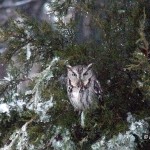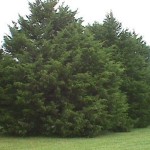By Edie Parnum
Each year we select two native plants with exceptional ability to support wildlife. These plants will contribute significantly to the web of life in your yard. They host insects, offer nectar and pollen, and produce fruits, seeds, or nuts. Birds, butterflies, and other insects and animals will feed and prosper. Most provide shelter and nesting places, too. Our selections, all native to southeastern Pennsylvania, are easy to grow and readily available at native plant nurseries or native plant sales. Our Prime Plants make attractive additions to your landscape. We offer awards in two categories: Trees and Shrubs and Perennials.
Our selections for the 2014 Prime Plants for Nature Awards are:
Eastern Red Cedar, Juniperus virginiana
Wildlife Value: This small evergreen tree is a powerhouse for nature. Yellow-rumped
Warbler, Eastern Bluebird, and Northern Mockingbird are among the 54 species of birds that eat its long-persisting berry-like cones during the cold months. Cedar Waxwings areso-named because they’re fond of cedar cones. The foliage hosts the Juniper Hairstreak butterfly, a vulnerable species in Pennsylvania, and several species of moths such as the Curve-lined Angle. Song Sparrows and other
birds use the dense foliage for nesting places and shelter. Don’t be tempted to buy the similar-looking Leyland Cypress, a non-native that offers little for wildlife.
Growing Conditions: The Eastern Red Cedar tolerates a wide variety of soils and dry to moist growing conditions. It prefers a sunny spot. These trees are either male or female. Only the female trees produce fruits, but you’ll also need a male for pollination.
By planting at least three of these trees, you will enhance their wildlife value. A row of cedars will provide dense shelter for birds. From the human perspective, the cedars can offer privacy. If planted on the north side of your house, they will create a windscreen.
Appearance: This evergreen has a pleasing conical shape. It grows at a moderate rate (1-2 feet per year) and reaches 15-40 feet at maturity.
Short-toothed Mountain Mint, Pycnanthemum muticum
Wildlife Value: This perennial is a magnet for pollinators. Butterflies, bees, wasps, and flies are attracted to the copious nectar and pollen this lovely plant produces. Because it
flowers over a long period of time, it may host thousands of visits by pollinators each season. With this plant in your yard, you can introduce children to pollination and teach them not to be afraid of bees and wasps.
Growing Conditions: Mountain Mint is a tough plant and will grow well in dry to moist soil in full to part-sun. Like other members of the mint family, it spreads but can easily be controlled, especially early in the growing season. It’s easy to transplant and share with other native plant gardeners. This perennial is deer-resistant, too.
Appearance: Mountain Mint grows to about 3-feet tall. Although the numerous flowers are small and inconspicuous, the foliage is an attractive silvery grey. The leaves complement other brightly colored flowers in the garden and in flower arrangements, too. This plant’s attractiveness is enhanced by the beautiful butterflies and other pollinating insects that visit.
Video © Barb Elliot. Pollinators visiting Short-toothed Mountain Mint. To see pollinator activity, click on symbol in lower right for full-screen view. Then click play symbol in lower left. May take several seconds to load. Turn on speakers for audio.
Plant these and other Backyards for Nature Prime Plants, and nature will flourish abundantly in your yard.






We just planted some virginia red cedar seedlings in Exton Park, so I was happy to see your thoughts about its uses.
And I just bought Pycnanthemum mutican – today- at Jenkins Arboretum for my own garden, but was hoping to find a seed source so I could seed some at Exton Park.
Do you know of any good place to buy it in bulk, or in seed form?
Thanks for you blog – I always find it inspiring.
Carol,
Glad you’re planting Eastern Red Cedar and Short-toothed Mountain Mint at Exton Park. Brandywine Conservancy sells seeds for native plants. You can contact them at 610-388-8327 or gardens@brandywine.org. An up-to-date list of sources for native plants, both retail and native plant sales, is on our website, http://www.valleyforgeaudubon.org/bfn. Jenkins Arboretum is on this list and has native plants for sale from now through some time in the fall.
Thanks for all your wonderful work at Exton Park.
Edie